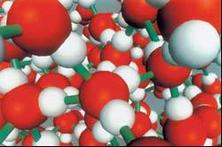Physical Mechanisms in Liquid Water

Water is a unique substance. It plays a major role in all living systems, and even small perturbations such as the substitution of deuterium for hydrogen are sufficient to destroy biological function. In living systems, essential water-related phenomena occur in restricted geometries in cells and organelles, and at active sites on membranes. The liquid-liquid phase transition hypothesis arose from molecular dynamics studies on the structure and equation of state of supercooled bulk water and has received some support. Below the hypothesized second critical point, the liquid phase separates into two distinct liquid phases: a low-density liquid (LDL) phase at low pressures and a high-density liquid (HDL) at high pressure. Bulk water near the known critical point at 647 K is a fluctuating mixture of molecules whose local structures resemble the liquid and gas phases. Similarly, bulk water near the hypothesized liquid-liquid critical point is a fluctuating mixture of molecules whose local structures resemble the two phases, LDL and HDL. These enhanced fluctuations influence the properties of liquid bulk water, thereby leading to anomalous behavior. Consistent with this hypothesis are recent MIT experiments, which our group is interpreting. We are also extending our work to the special layer of water surrounding a protein (“hydration water”), which appears to have a dynamic crossover not unlike that observed for water confined in 1D nanopores.
 Physics (Internal)
Physics (Internal)